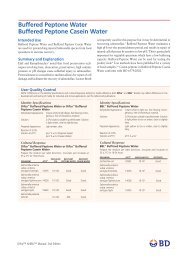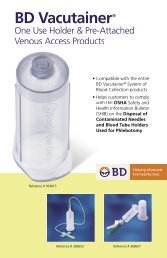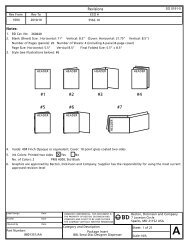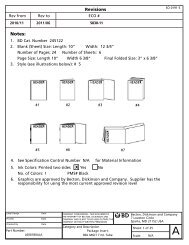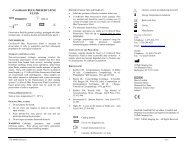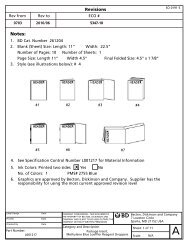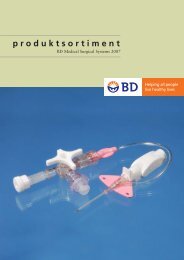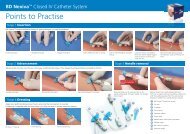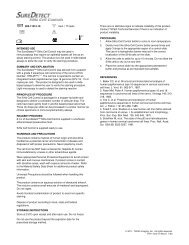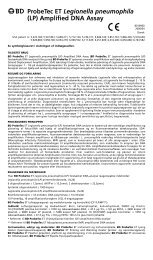Notes: - BD
Notes: - BD
Notes: - BD
Create successful ePaper yourself
Turn your PDF publications into a flip-book with our unique Google optimized e-Paper software.
SPECIMEN COLLECTION<br />
The specimen must be collected using sterile techniques to reduce the chance of contamination. The typical specimen volume is 8 – 10 mL. It is<br />
recommended that the specimen be inoculated into the BACTEC vials at bedside. Most commonly, a 10 cc or 20 cc syringe with a Luer-Lok brand tip is<br />
used to draw the sample. If appropriate, a Vacutainer Brand Needle Holder and a Vacutainer Brand Blood Collection Set, Vacutainer Safety-Lok<br />
Blood Collection Set or other tubing “butterfly” set may be used. If using a needle and tubing set (direct draw), carefully observe the direction of blood<br />
flow when starting sample collection. The vacuum in the vial will usually exceed 10 mL, so the user should monitor the volume collected by means of<br />
the 5 mL graduation marks on the vial label. When the desired 8 – 10 mL has been drawn, the flow should be stopped by crimping the tubing and<br />
removing the tubing set from the BACTEC vial. Sample volumes as low as 3 mL can be used, however, recovery will not be as great as with larger<br />
volumes. The inoculated BACTEC vial should be transported as quickly as possible to the laboratory. A yellow-top Vacutainer Brand Tube containing<br />
SPS may also be used to collect the blood sample from the patient. The tube should be transported to the laboratory as quickly as possible for transfer<br />
into the BACTEC culture vial.<br />
PROCEDURE<br />
Remove the flip-off cap from BACTEC vial top and inspect the vial for cracks, contamination, excessive cloudiness, and bulging or indented stoppers. DO<br />
NOT USE if any defect is noted. Before inoculating, swab the septum with alcohol (iodine is not recommended). Aseptically inject or draw directly<br />
8 – 10 mL of specimen per vial. The medium is designed for use with blood specimens ranging from 3 to 10 mL. If the sample is less than 3 mL, recovery<br />
will not be as great as with larger volumes (see Limitations of the Procedure). Inoculated vials should be placed in the BACTEC fluorescent series<br />
instrument as soon as possible for incubation and monitoring. If placement of an inoculated vial into the instrument has been delayed and visible<br />
growth is apparent, it should not be tested in the BACTEC fluorescent series instrument, but rather it should be subcultured, appropriately stained and<br />
treated as a presumptively positive bottle.<br />
Vials entered into the instrument will be automatically tested every ten minutes for the duration of the testing protocol period. Positive vials will be<br />
determined by the BACTEC fluorescent series instrument and identified as such (see the appropriate BACTEC fluorescent series instrument User’s<br />
Manual). The sensor inside the bottle will not appear visibly different in positive and negative vials, however the BACTEC fluorescent series instrument<br />
can determine a difference in fluorescence.<br />
If at the end of the testing period a negative BACTEC Mycosis-IC/F vial appears visually positive (i.e., bulging septum, and/or turbid), it should be<br />
subcultured, appropriately stained and treated as a presumptive positive.<br />
Positive vials should be subcultured and stained appropriately. In a great majority of cases, organisms will be seen and a preliminary report can be made<br />
to the physician.<br />
Subculturing: Prior to subculturing, put the vial in an upright position, and place an alcohol wipe over the septum. To release pressure in the vial, insert<br />
a sterile needle with an appropriate filter or pledget through the alcohol wipe and septum. The needle should be removed after the pressure is<br />
released and before sampling the vial for subculture. The insertion and withdrawal of the needle should be done in a straight-line motion, avoiding any<br />
twisting motions.<br />
For maximum yield of isolates, negative cultures may be checked by stain and/or subcultured at some point prior to discarding as negative.<br />
QUALITY CONTROL<br />
Quality control requirements must be performed in accordance with applicable local, state and/or federal regulations or accreditation requirements and<br />
your laboratory's standard Quality Control procedures. It is recommended that the user refer to pertinent CLSI (formerly NCCLS) guidance and CLIA<br />
regulations for appropriate Quality Control practices.<br />
DO NOT USE culture vials past their expiration date.<br />
DO NOT USE culture vials that exhibit any cracks or defects; discard the vial in the appropriate manner.<br />
Quality Control Certificates are provided with each carton of media. Quality Control Certificates show test organisms, including ATCC cultures<br />
specified in the CLSI Standard, Quality Control for Commercially Prepared Microbiological Culture Media. 5<br />
The range of time-to-detection in hours was ≤ 72 hours for each of the organisms listed on the Quality Control Certificate for this medium:<br />
Organism<br />
Candida albicans* ATCC 10231 Candida parapsilosis ATCC 10232 Candida (Torulopsis) glabrata ATCC 15545<br />
Candida albicans ATCC 14053 Candida krusei ATCC 34135 Cryptococcus neoformans ATCC 13690<br />
Candida tropicalis ATCC 750<br />
*CLSI Strain<br />
It is recommended that each shipment of media be tested for performance through the use of a positive and negative vial test. The positive vial<br />
should be inoculated with 0.1 mL of a 0.5 McFarland Standard of either Candida albicans (ATCC 10231) or Candida (Torulopsis) glabrata. This vial<br />
and an uninoculated vial should be logged into the instrument and tested. The inoculated vial should be detected as positive by the instrument<br />
within 72 hours. The negative control vial should remain negative. This verifies that the media were not subject to adverse storage or shipping<br />
conditions prior to receipt in your laboratory. If either of these vials do not give the expected results, do not use the media until you have contacted<br />
Technical Services at 1-800-638-8663, or your <strong>BD</strong> representative.<br />
For information on Quality Control for the BACTEC fluorescent series instrument, refer to the appropriate BACTEC fluorescent series instrument User’s<br />
Manual.<br />
LIMITATIONS OF THE PROCEDURE<br />
Contamination<br />
Care must be taken to prevent contamination of the sample during collection and inoculation into the BACTEC vial. A contaminated sample will give a<br />
positive reading, but will not indicate a relevant clinical sample. Such a determination must be made by the user based on such factors as type of<br />
organisms recovered, occurrence of the same organism in multiple cultures, patient history, etc.<br />
Nonviable Organisms<br />
A Gram-stained smear from culture medium may contain small numbers of nonviable organisms derived from media constituents, staining reagents,<br />
immersion oil, glass slides, and specimens used for inoculation. In addition, the patient specimen may contain organisms that will not grow in the<br />
culture medium or in media used for subculture. Such specimens should be subcultured to special media as appropriate. 6<br />
Dimorphic fungi<br />
Mycosis-IC/F Medium has been optimized for the recovery of yeast. The medium has not been proven effective for the recovery of dimorphic fungi.<br />
General Considerations<br />
Optimum recovery of isolates will be achieved by adding 8 – 10 mL of blood. Use of lower or higher volumes may adversely affect recovery and/or<br />
detection times. Blood may contain antimicrobials or other inhibitors which may slow or prevent the growth of microorganisms. False negative readings<br />
may result when certain organisms are present which do not produce enough CO2 to be detected by the system or significant growth has occurred<br />
before placing the vial into the system. False positivity may occur when the white blood cell count is high.<br />
Due to the nature of biological materials in media products and inherent organism variability, the user should be cognizant of potential variable results<br />
in the recovery of certain microorganisms.<br />
2




